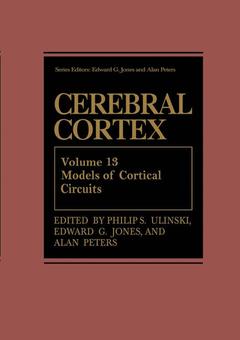Cerebral Cortex, Softcover reprint of the original 1st ed. 1999 Models of Cortical Circuits Cerebral Cortex Series, Vol. 13
Langue : Anglais
Coordonnateur : Ulinski Philip S.

This volume is devoted to mathematical models of the cortex. Computational models of individual neurons and ensembles of neurons are increasingly used in research on cortical organization and function. This is, in part, because of the now ubiquitous presence of powerful and affordable computers. The volume begins with a short history of models of cortical neurons and circuitry that introduces the principal modeling styles. An attempt has been made throughout the volume to make it accessible to readers with minimal mathematical backgrounds.
1 Modeling Cortical Circuitry: A History and Prospectus.- 1. Introduction.- 2. Lorente de Nó through Dynamical Systems Models.- 3. Hodgkin and Huxley through Network Models.- 4. Prospectus.- 5. References.- 2 Interpretations of Data and Mechanisms for Hippocampal Pyramidal Cell Models.- 1. Introduction.- 2. The Database for Single-Neuron Models.- 3. Strategies for Single-Neuron Models.- 4. Anatomy and the Model: Data and Methods.- 5. The Linear Model: Data and Methods.- 6. Phenomenological Templates.- 7. Review of Hippocampal Models.- 8. Channel Models.- 9. Ionic Concentration Dynamics.- 10. Nonsynaptic Channels of Hippocampal Pyramidal Cells.- 11. HPC Sodium Channels.- 12. HPC Calcium Channels.- 13. HPC Potassium Channels.- 14. Nonspecific Cation and Chloride Currents.- 15. Simulations of HPC Properties with the Working Model.- 16. References.- 3 Functional Implications of Active Currents in the Dendrites of Pyramidal Neurons.- 1. Introduction.- 2. Historical Perspective.- 3. Amplification of Synaptic Inputs.- 4. Compartment Model Simulations of Amplification.- 5. Effects of Dendritic Active Currents on EPSP Shape.- 6. The Effect of Dendritic Active Currents in Shaping the Intrinsic Firing Properties of Pyramidal Cells.- 7. Effects of Potassium Currents.- 8. Linking Firing of the Soma to Depolarization at Distal Synapses and the Implementation of Hebb’s Hypothesis.- 9. Apologies.- 10. Concluding Observations.- 11. References.- 4 Comparing Different Modeling Approaches of Visual Cortical Cell Characteristics.- 1. Introduction.- 2. Foundations.- 3. Models of Cortical Orientation Specificity.- 4. Concluding Remarks.- 5. Appendix.- 6. References.- 5 The Role of Recurrent Excitation in Neocortical Circuits.- 1. Introduction.- 2. Wiring Neocortical Circuits.- 3. CanonicalMicrocircuits.- 4. Units of Construction of the Basic Cortical Circuit.- 5. The Neuronal Components of Layer 4.- 6. Computation of Orientation.- 7. Noise and Restoration.- 8. References.- 6 Neural Mechanisms Underlying the Analysis of Moving Visual Stimuli.- 1. Introduction.- 2. A Primer of Basic Concepts.- 3. Neural Mechanisms: Mammals.- 4. Neural Mechanisms: Turtles.- 5. Conclusions and Future Directions.- 6. References.- 7 Linearity and Gain Control in VI Simple Cells.- 1. Introduction.- 2. The Linear Model of Simple Cells.- 3. Some Linear Properties of Simple Cells.- 4. Biophysics of the Linear Model.- 5. Some Nonlinear Properties of Simple Cells.- 6. The Normalization Model of Simple Cells.- 7. Testing the Normalization Model.- 8. Biophysical Plausibility of the Normalization Model.- 9. Conclusions.- 10. References.- 8 Non-Fourier Cortical Processes in Texture, Form, and Motion Perception.- 1. Introduction.- 2. Analysis of Texture Boundaries by Non-Fourier Mechanisms.- 3. Area V4 Neurons and Form Vision.- 4. Two-Dimensional Motion.- 5. Discussion.- 6. References.- 9 Modeling Thalamocortical Oscillations.- 1. Slow Thalamic Rhythms.- 2. Thalamus as Magnet for Modeling—Dynamics and Neural Systems.- 3. Early Modeling Predicted a Role for Inhibitory Phasing.- 4. Modeling the T Channel.- 5. Modeling the Low-Threshold Spike.- 6. The Basic Two-Neuron Network.- 7. The Search for Origins: Whence Spindling?.- 8. Synchrony and Spread of Network Activity.- 9. Summary and Conclusions.- 10. References.- 10 Realistic Network Models of Synchronized Oscillations in Visual Cortex.- 1. Introduction.- 2. Model Structure.- 3. Model Results.- 4. Conclusion.- 5. References.- 11 Modeling the Piriform Cortex.- 1. Introduction.- 2. Summary of Data Being Modeled.- 3. Modeling ofPhysiological Data.- 4. Modeling of Functional Hypotheses.- 5. Summary and Future Directions.- 6. References.
Date de parution : 09-2012
Ouvrage de 573 p.
17.8x25.4 cm
Disponible chez l'éditeur (délai d'approvisionnement : 15 jours).
Prix indicatif 210,99 €
Ajouter au panierThèmes de Cerebral Cortex :
Mots-clés :
cell; cerebral cortex; cortex; neural mechanisms; neurons; perception; thoracic surgery
© 2024 LAVOISIER S.A.S.



